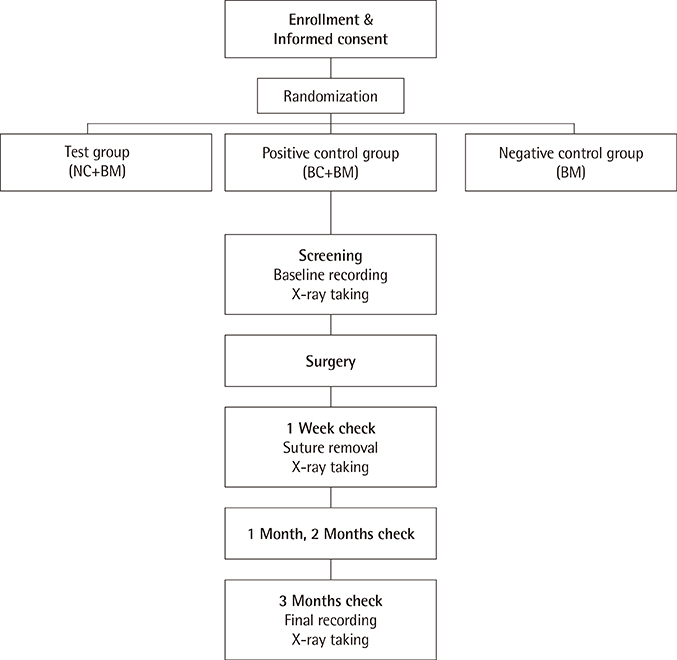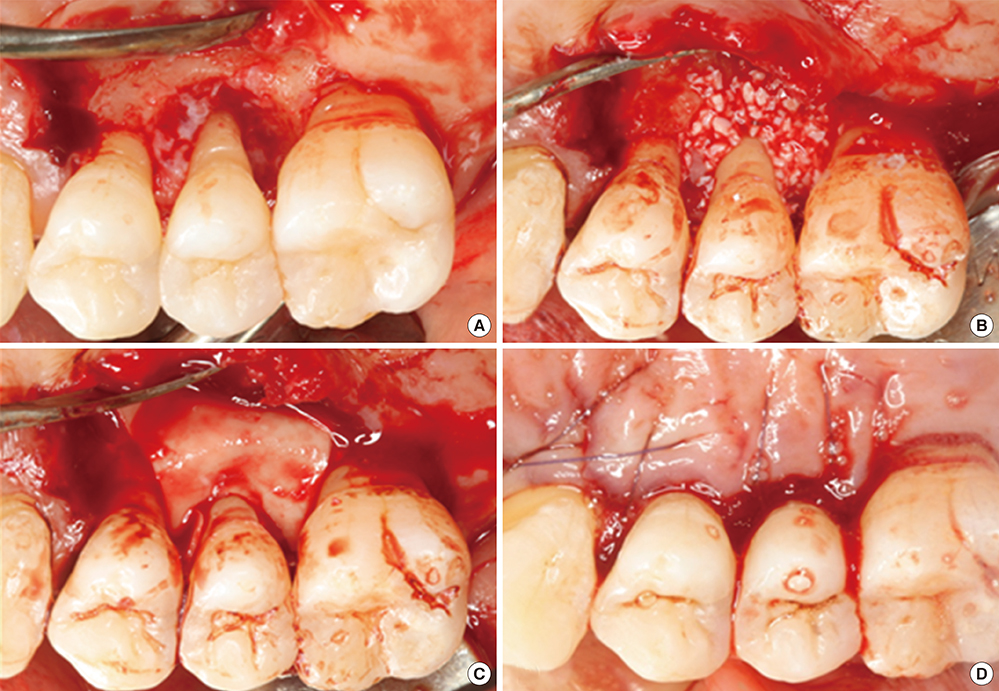J Periodontal Implant Sci.
2014 Aug;44(4):194-200. 10.5051/jpis.2014.44.4.194.
Comparative study of two collagen membranes for guided tissue regeneration therapy in periodontal intrabony defects: a randomized clinical trial
- Affiliations
-
- 1Department of Periodontology, Wonkwang University Daejeon Dental Hospital, Wonkwang University School of Dentistry, Daejeon, Korea. seongnyum@wonkwang.ac.kr
- 2Research Institute, NIBEC, Seoul, Korea.
- KMID: 2212013
- DOI: http://doi.org/10.5051/jpis.2014.44.4.194
Abstract
- PURPOSE
The purpose of this study was to assess and compare the clinical and radiographic outcomes of guided tissue regeneration therapy for human periodontal intrabony defects using two different collagen membranes: a porous nonchemical cross-linking collagen membrane (NC) and a bilayer collagen membrane (BC).
METHODS
Thirty subjects were randomly assigned and divided into the following 3 groups: a test group (NC+BM), in which a NC was used with xenograft bone mineral (BM), a positive control group (BC+BM), in which a BC was used with xenograft BM, and a negative control group (BM), in which only xenograft BM was used. The following clinical measurements were taken at baseline and 3 months after surgery: plaque index, gingival index, probing pocket depth, gingival recession, and clinical attachment level. Radiographic analysis was performed at baseline, 1 week and 3 months after surgery.
RESULTS
Membrane exposure was not observed in any cases. Significant probing depth reduction, attachment-level gain and bone fill were observed for both test and control groups compared to baseline at 3 months after surgery (P<0.05). However, there were no statistically significant differences in clinical improvement and radiographic bone fill between treatment protocols (P>0.05).
CONCLUSIONS
Within the limitations of this study, the results suggest that both NC and BC were comparable in terms of clinical and radiographic outcomes for the treatment of periodontal intrabony defects in human subjects.
MeSH Terms
Figure
Reference
-
1. Caton J, Nyman S, Zander H. Histometric evaluation of periodontal surgery. II. Connective tissue attachment levels after four regenerative procedures. J Clin Periodontol. 1980; 7:224–231.
Article2. Zucchelli G, Bernardi F, Montebugnoli L, De SM. Enamel matrix proteins and guided tissue regeneration with titanium-reinforced expanded polytetrafluoroethylene membranes in the treatment of infrabony defects: a comparative controlled clinical trial. J Periodontol. 2002; 73:3–12.
Article3. Melcher AH. On the repair potential of periodontal tissues. J Periodontol. 1976; 47:256–260.
Article4. Karring T, Nyman S, Gottlow J, Laurell L. Development of the biological concept of guided tissue regeneration: animal and human studies. Periodontol 2000. 1993; 1:26–35.
Article5. Cortellini P, Clauser C, Prato GP. Histologic assessment of new attachment following the treatment of a human buccal recession by means of a guided tissue regeneration procedure. J Periodontol. 1993; 64:387–391.
Article6. Nyman S, Lindhe J, Karring T, Rylander H. New attachment following surgical treatment of human periodontal disease. J Clin Periodontol. 1982; 9:290–296.
Article7. Stahl SS, Froum S, Tarnow D. Human histologic responses to guided tissue regenerative techniques in intrabony lesions. Case reports on 9 sites. J Clin Periodontol. 1990; 17:191–198.
Article8. Hardwick R, Scantlebury TV, Sanchez R, Whitley N, Ambruster J. Membrane design criteria for guided bone regeneration of the alveolar ridge. In : Buser D, Dahlin C, Schenk RK, editors. Guided bone regeneration in implant dentistry. Chicago: Quintessence;1994. p. 101–136.9. Haney JM, Nilveus RE, McMillan PJ, Wikesjo UM. Periodontal repair in dogs: expanded polytetrafluoroethylene barrier membranes support wound stabilization and enhance bone regeneration. J Periodontol. 1993; 64:883–890.
Article10. Black BS, Gher ME, Sandifer JB, Fucini SE, Richardson AC. Comparative study of collagen and expanded polytetrafluoroethylene membranes in the treatment of human class II furcation defects. J Periodontol. 1994; 65:598–604.
Article11. Robert PM, Frank RM. Periodontal guided tissue regeneration with a new resorbable polylactic acid membrane. J Periodontol. 1994; 65:414–422.
Article12. Chvapil M. Reconstituted collagen. In : Viidik A, Vuust J, editors. Biology of collagen. London: Academic Press;1980. p. 313–325.13. Rao KP, Joseph T. Collagen graft copolymers and their biomedical applications. In : Nimni ME, editor. Collagen, vol. III. Biotechnology. Boca Raton, FL: CRC Press Inc.;1988. p. 63–86.14. Quteish D, Dolby AE. The use of irradiated-crosslinked human collagen membrane in guided tissue regeneration. J Clin Periodontol. 1992; 19:476–484.
Article15. Olde Damink LH, Dijkstra PJ, Van Luyn MJ, Van Wachem PB, Nieuwenhuis P, Feijen J. Glutaraldehyde as a crosslinking agent for collagen-based biomaterials. J Mater Sci Mater Med. 1995; 6:460–472.
Article16. Rothamel D, Schwarz F, Sculean A, Herten M, Scherbaum W, Becker J. Biocompatibility of various collagen membranes in cultures of human PDL fibroblasts and human osteoblast-like cells. Clin Oral Implants Res. 2004; 15:443–449.
Article17. Lee CK, Koo KT, Kim TI, Seol YJ, Lee YM, Rhyu IC, et al. Biological effects of a porcine-derived collagen membrane on intrabony defects. J Periodontal Implant Sci. 2010; 40:232–238.
Article18. Camelo M, Nevins ML, Schenk RK, Simion M, Rasperini G, Lynch SE, et al. Clinical, radiographic, and histologic evaluation of human periodontal defects treated with Bio-Oss and Bio-Gide. Int J Periodontics Restorative Dent. 1998; 18:321–331.19. Camelo M, Nevins ML, Lynch SE, Schenk RK, Simion M, Nevins M. Periodontal regeneration with an autogenous bone-Bio-Oss composite graft and a Bio-Gide membrane. Int J Periodontics Restorative Dent. 2001; 21:109–119.20. Loe H. The gingival index, the plaque index and the retention index systems. J Periodontol. 1967; 38:610–616.
Article21. Magnusson I, Batich C, Collins BR. New attachment formation following controlled tissue regeneration using biodegradable membranes. J Periodontol. 1988; 59:1–6.
Article22. Zahedi S, Legrand R, Brunel G, Albert A, Dewe W, Coumans B, et al. Evaluation of a diphenylphosphorylazide-crosslinked collagen membrane for guided bone regeneration in mandibular defects in rats. J Periodontol. 1998; 69:1238–1246.
Article23. Hammerle CH, Lang NP. Single stage surgery combining transmucosal implant placement with guided bone regeneration and bioresorbable materials. Clin Oral Implants Res. 2001; 12:9–18.
Article24. Zitzmann NU, Naef R, Scharer P. Resorbable versus nonresorbable membranes in combination with Bio-Oss for guided bone regeneration. Int J Oral Maxillofac Implants. 1997; 12:844–852.25. Trombelli L, Heitz-Mayfield LJ, Needleman I, Moles D, Scabbia A. A systematic review of graft materials and biological agents for periodontal intraosseous defects. J Clin Periodontol. 2002; 29:Suppl 3. 117–135.
Article26. Hugoson A, Ravald N, Fornell J, Johard G, Teiwik A, Gottlow J. Treatment of class II furcation involvements in humans with bioresorbable and nonresorbable guided tissue regeneration barriers. A randomized multi-center study. J Periodontol. 1995; 66:624–634.
Article27. Sanz M, Tonetti MS, Zabalegui I, Sicilia A, Blanco J, Rebelo H, et al. Treatment of intrabony defects with enamel matrix proteins or barrier membranes: results from a multicenter practice-based clinical trial. J Periodontol. 2004; 75:726–733.
Article28. Nevins M, Giannobile WV, McGuire MK, Kao RT, Mellonig JT, Hinrichs JE, et al. Platelet-derived growth factor stimulates bone fill and rate of attachment level gain: results of a large multicenter randomized controlled trial. J Periodontol. 2005; 76:2205–2215.
Article29. Sculean A, Windisch P, Chiantella GC, Donos N, Brecx M, Reich E. Treatment of intrabony defects with enamel matrix proteins and guided tissue regeneration. A prospective controlled clinical study. J Clin Periodontol. 2001; 28:397–403.
Article30. Trombelli L, Kim CK, Zimmerman GJ, Wikesjo UM. Retrospective analysis of factors related to clinical outcome of guided tissue regeneration procedures in intrabony defects. J Clin Periodontol. 1997; 24:366–371.
Article
- Full Text Links
- Actions
-
Cited
- CITED
-
- Close
- Share
- Similar articles
-
- Periodontal regenerative effect of a bovine hydroxyapatite/collagen block in one-wall intrabony defects in dogs: a histometric analysis
- Additional use of autogenous periosteal barrier membrane combined with regenerative therapy in the interproximal intrabony defects: case series
- A randomized controlled clinical study of periodontal tissue regeneration using an extracellular matrix-based resorbable membrane in combination with a collagenated bovine bone graft in intrabony defects
- A Retrospective Study of the Clinical Outcome of Guided Tissue Regeneration in infrabony defects
- Evaluation of calcium sulphate barrier to collagen membrane in intrabony defects




